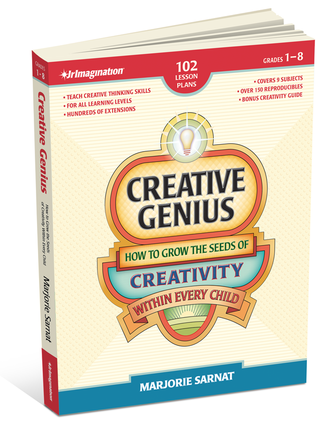Advice from Outside the Box
 Tuesday, March 13, 2012 at 5:00AM |
Tuesday, March 13, 2012 at 5:00AM |  Marjorie Sarnat
Marjorie Sarnat To live successfully—both personally and professionally—you must identify problems and think of ways to solve them. And if your first attempts don’t work, you need the ability to formulate Plan B, C, D, and Q. You must figure out ways around roadblocks, come up with quick fixes for little emergencies, and design effective strategies for tackling serious problems. Creative thinkers are best equipped to navigate the challenges of life. 
Here are some of my favorite anecdotes featuring creative problem solvers. These lighthearted examples are from everyday life, but their “outside the box” approach is relevant to all problems that need solving.
A Funny Way to Cope
This is a true story. I took “Psychology of Personality” at Boston University. I had read all but two chapters among the required books. Our final exam consisted of just one essay question: Apply the principles of analysis to a specified character in a chapter I had not read!
Realizing I might flunk this class, I tried to salvage what I could. I wrote a note to Professor Smith (his real name) at the top of my page, admitting the truth and asking for some credit for whatever knowledge I could demonstrate. And I expressed hope that he might enjoy my writings— regardless of my grade.
Since I knew the principles of analysis I applied them to someone familiar to all of us: Benjamin Franklin. With little to lose and an hour to kill, I wrote a humorous essay using Ben Franklin’s proverbs to prove my points. While my classmates struggled and sweated, I giggled my way through the final. “A penny saved is a penny earned” shows an anal retentive personality and “Fish and visitors stink after three days” describes an OCD personality with a possible fish phobia. I explained how it all works.
A few days later I was astounded to see an A+ on my exam, along with a note from the professor: "The highest goal of psychology studies is to help people cope with life. You deserve an A+."
Ideas by the Bunch
 I read this anecdote (wish I could recall where) about a child taking the Minnesota Test for Creative Thinking developed by Dr. E. Paul Torrance.
I read this anecdote (wish I could recall where) about a child taking the Minnesota Test for Creative Thinking developed by Dr. E. Paul Torrance.
The child was working on the Circles and Squares Task. She had 42 circles to fill in with sketches of things and was making slow progress. When the teacher announced that there was only one minute left the child quickly drew a man at the bottom of her page of circles and added lines from his hand to each of the circles to show a balloon man.
How would you evaluate this imaginative solution compared to the solutions of other kids who sketched 42 different things? What she may have lacked in fluency (numbers of ideas) she made up in originality (unusual and unexpected solutions.) Creativity can manifest in more than one way.
The Cheadle Challenge
My high school English teacher cared more about form than content. These were the days of pens and typewriters when Bill Gates and Steve Jobs were still in school themselves. For an important assignment Ms. Cheadle declared that she would not accept any paper with eraser smudges, crossed out words, whited-out words, taped-over words, nor written-over words. But she never mentioned cut-out words. She may have thought she covered every loophole but Ms. Cheadle had not seen divergent thinking in action.
I tried to write my paper according to her specifications, but being a human student, I made some errors. I was not about to rewrite an entire page because of a silly formality. So I took a razor knife and literally cut my mistakes out; my pages looked like doilies.
I handed in my work and watched for Ms. Cheadle’s reaction. She picked up my papers, paused, then started to cry. I felt bad for her. She clearly needed to get outside more—outside the box, that is.
A Slice Of Creative Life
My friend’s neighbor, Carla, found herself stranded one day without a car and without enough money for a taxi home. But she did have an idea, thanks to “flexible thinking.” Carla noticed a nearby pizza place, walked in, and ordered a pizza for delivery to her home. She waited for the delivery guy to get into his car with her pizza and hitched a ride. She was home in 30 minutes or less, guaranteed, while the pizza was still hot.
Creativity isn't always about producing things. Sometimes people use their creativity to respond to unexpected challenges in everyday life. If your child or someone you know solved a problem in a creative way, tell us the story in the comments.



